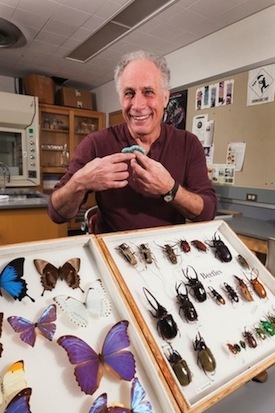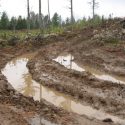Wisconsin’s new ‘bug guy,’ insect detective arrives on campus
PJ Liesch — or less formally, the ”bug guy” — holds one of many insects he inspects at his office in Russell Labs. Liesch recently took over as manager of the UW Insect Diagnostic Lab, succeeding longtime manager Phil Pellitteri.
His favorite insect is one he has actually never seen alive in the wild.
It lives on snowfields and glaciers in the American West, aptly named an ice crawler. Simply picking it up may warm its body enough to kill it. But PJ Liesch, the University of Wisconsin–Madison’s new “bug guy,” continues to search for it.
“I’ve been out West looking for them a couple of times and haven’t had any luck, so they’re kind of one I have on my bucket list, just to see one of those out in the wild,” says Liesch, whose German surname is pronounced like “leash.”

After decades of helping students and concerned citizens understand insects, Phil Pellitteri retired this year.
Photo: UW–Madison CALS
The insect specialist officially took over as manager of the UW-Madison Insect Diagnostic Lab this summer, following the retirement of longtime manager and beloved “bug guy” Phil Pellitteri. But it wasn’t his first crawl through the lab.
Liesch grew up in Racine County, in “a little farm town called Franksville,” he says. He went to J.I. Case High School, and then on to the University of Wisconsin-Parkside, where he majored in biological sciences. He was a sophomore in 2005 when he was “bitten by the insect bug” while working with UW–Madison Extension’s Chris Williamson, a professor of entomology and turf grass and ornamental plant insect specialist.
“At the time, emerald ash borer was starting to get a lot of press — it was becoming an issue — and I did two years of a summer internship with Chris, conducting surveys looking for that insect in southeast Wisconsin,” says Liesch. “As I finished up the second year of the internship, Chris asked if I was interested in potentially pursuing some graduate work.”
And so it was, that just weeks after graduating from UW-Parkside in May 2007, Liesch found himself working on his master’s degree in Williamson’s lab, just two doors down from the Insect Diagnostic Lab.
After earning that degree, Liesch continued to work with Williamson and Jim Kerns, a then-UW-Madison assistant professor and extension specialist in plant pathology, as a research scientist, “conducting all kinds of work with ornamentals and turf grass.” He had just agreed to teach the insect portion of the College of Agricultural and Life Science’s Farm and Industry Short Course when Pellitteri announced his retirement this February. Liesch stepped in as manager on an interim basis, but was officially dubbed the new “bug guy” in July.
“In a lot of cases, people will contact the lab because they have an insect show up and the main thing they want to know: ‘Is it poisonous? Is it harmful?’”
PJ Liesch
The three-and-a-half years he spent as a researcher have proven invaluable.
“I get calls from arborists and landscape maintenance folks, just wondering: ‘What is this pest on this rose bush?’ for example, ‘what do we need to do about it?’ and I can say I’ve done an experiment with that one, I’ve seen that one out in the field and captured it with my bare hands,” Liesch says.
The lab kept Liesch busy this summer, when he “frantically” cranked through 100-125 “cases” in a typical week. He is, in a sense, an insect detective.
“On days I’m in the lab, I’m answering phone calls, answering emails from the general public, we have samples that arrive in the mail each day,” says Liesch, “so it’s kind of this continual process of samples and cases and responding to the phone calls from people.
“In a lot of cases, people will contact the lab because they have an insect show up and the main thing they want to know: ‘Is it poisonous? Is it harmful? Is it going to harm me or my kids or my pets?’ (There are) very few cases where that’s actually the situation.”
Take the time he received a picture of an unusual insect from South Africa. It was a shiny metallic bug, with tufts of orange hairs sticking out of its body.
“I looked at it and was having a hard time figuring out (whether it was) a beetle or some type of grasshopper,” says Liesch. “I had a hunch that it was a beetle and I started doing some digging and it ended up being a type of metallic wood-boring beetle.”
PJ Liesch looks through a microscope beside samples of insects at his workspace. “It certainly has been exciting to take over the managerial position (at the Insect Diagnostic Lab) and be the go-to bug guy in the state,” he says.
Or, there was the time this summer when a very large but dead spider showed up in a crate of goods from Indonesia, shipped to a Kenosha-area department store.
“If you happen to hop on the Internet and start doing Google searches for very large spiders, there’s all sorts of scary stories out there, most of them may or may not be true. But the employees simply wanted to know: ‘Is this some potentially threatening species? Do we need to keep an eye out for other things?’” says Liesch.
The employees sent the spider to the lab — he can only accept insects found in Wisconsin, due to regulatory laws — and looked at it under the microscope to confirm that it is actually a fairly common, harmless species of spider usually found in tropical and subtropical regions.
When he’s not in the lab, Liesch is on the road, giving lectures to master gardeners around the state, and participating in events like the Wisconsin State Fair. Or, he can be found out in the field, collecting specimens. Beetles, he says, are best: “They’re the most diverse group of insects on the planet and beetles are absolutely everywhere.”
Liesch notes that some of his greatest collecting can be done right at the light on his back porch, in rural Dane County.
The lab kept Liesch busy this summer, when he ‘frantically’ cranked through 100-125 ‘cases’ in a typical week. He is, in a sense, an insect detective.
“You’d be amazed at all the different species of moths that can show up in a night,” says Liesch.
Interacting with the public is one of his favorite aspects of the new job. When he receives an inquiry, he not only does his best to answer the question, he also tries to provide more information about the insect and to share additional photos and links to help people learn more.
Liesch started a brand-new blog — What’s Crawling in the Lab — to share what people in Wisconsin are finding in their homes, backyards, forests and fields. He also started a Twitter account people can use to reach him, @UW_InsectLab. He’s adapting to the day-to-day variation in his duties.
“I had a pretty good idea how the lab was run,” Liesch says. “I knew Phil very well and we’d chat about things frequently because when I was doing research here after my master’s, I’d see things out in the field and let Phil know what I was seeing with Japanese beetle populations, what was going on with emerald ash borers in research trials, that sort of thing.
“It certainly has been exciting to take over the managerial position and be the go-to bug guy in the state.”


